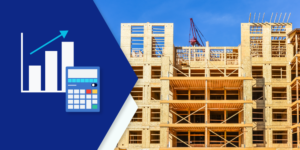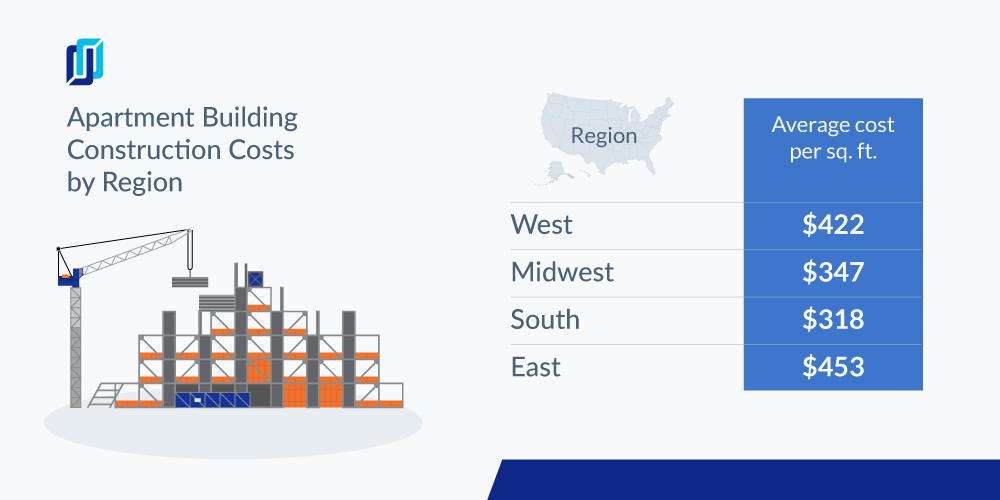
Across the nation, the average cost to build an apartment complex is $398 per square foot. That means a complex with 100 average-sized units would cost around $37 million to construct.
However, there are many factors that affect this price: the complexity of the design, level of finish size, and, possibly most importantly, the region in which the construction is taking place. We’ll cover all of these factors, so read on for more details about how much it costs to build an apartment complex.
Factors affecting apartment complex construction costs
The following table uses data compiled from Cumming Corporation’s US Construction Costs Per Square Foot Report from 2021. We took the values for each city and developed averages for each region to provide an estimate of the cost to build an apartment complex per square foot.

Those numbers break down to a national average cost to build an apartment complex of $398 per square foot, but the region clearly plays a part. And these figures are based on apartments and condominium construction of mid-rise buildings. Generally speaking, “mid-rise” loosely describes buildings between 5 and 10 stories.
While having a square-foot cost helps estimate how much a commercial building might cost, this figure doesn’t paint the whole picture. When breaking down the cost to build an apartment complex, contractors, project owners, developers, and investors need to consider the different costs wrapped up in those cost-per-square-foot estimates.
- Hard Costs account for the materials, labor, equipment, property, site work, utilities, and other expenses directly related to building the apartment complex.
- Soft Costs include the money spent on taxes, fees, permits, designs, drawings, engineering, inspections, and other costs not directly related to the actual apartment complex’s construction.
- Finance Costs include the cost to borrow money through interest, origination fees, and finance charges, whether these monies come from banks or investors.
- Long-term Costs include the costs of maintaining the systems, utilities, and other monthly expenses directly related to the building’s design. This could include the cost of maintaining the complex’s elevators, pools, laundry equipment, and other amenities. It’s challenging to account for these costs in a cost-per-square-foot estimate, but these are expenses that investors and developers need to keep in mind.
On top of those costs, project owners, investors, and developers should keep an eye on costs related to delays and disputes. Payment disputes can cause delays in the apartment complex’s progress, as well as lawsuits that drag the entire project down. In fact, not paying contractors on time can even result in foreclosure on the property.
While these are costs that everyone on the project should consider, they are often avoidable. Developers and project owners should review their prospective GC’s payment histories to avoid selecting one with a past riddled with delays and disputes.
Apartment complex planning and construction
As with any building or development project, developers and project owners have a lot of factors to understand and consider. Between the costs and what impacts them, as well as choosing materials, there is a lot to know.
What impacts costs
The cost to build an apartment complex is subject to many factors. Obviously, the region in which the project exists is a major component to estimating the cost. Building an apartment complex (or any type of building) in the East or West is typically more expensive than the same project in the Midwest or South.
It’s also important to consider demand. The cost to build an apartment complex will be higher in areas experiencing construction booms. In these areas, contractors have many projects to choose from, so they don’t need to be as competitive with their bids. In areas where construction is slow, bids may be lower as contractors are pining for jobs to keep their calendars full.
Also, should union labor be a requirement, the cost of building the construction complex will be significantly higher. Unions pay higher wages and offer training and benefits to their members, and company owners need to bid higher to cover the costs.
Selecting materials
One of the most significant factors affecting the cost to build an apartment complex is materials selection. Apartments with basic fixtures and furnishings will be significantly less expensive to build than those with luxury-grade finishes.
Material volume is a factor, as well. The building of an apartment complex is typically repetitive, with the same materials used in each apartment. For that reason, contractors need to order large quantities of the same materials. Should those materials run short or become unavailable, delays will occur. And, if the price of those materials jumps 10 or 15 percent overnight, the overall cost to build the apartment complex will jump.
For these reasons, contractors might consider using materials financing to lock in prices and take advantage of materials being in stock.
Who plays a role in the process of building an apartment complex
Any construction project will include a few moving parts, but projects at the scale of an apartment complex will involve many players. The project might start with a developer and some investors, but the actual process of planning and building the apartment complex takes many hands.
The architect
In the beginning stages of the apartment complex’s development, the project owner needs to hire an architect. Their main job is to design and draw plans that contractors will follow to build the complex. They’ll arrange every aspect of the building, from the engineering to the fixtures and finishes. The architect will also help the project owner with an initial budget.
Most architecture firms will also assist the developer or owner in choosing a general contractor. They can even act as a project manager and oversee the project.
General contractor
When it comes to building the apartment complex, the architect and project owner will select a general contractor. Their job is to handle permits and inspections, hire all the subcontractors, and manage the general direction of the apartment complex’s construction. They’ll typically enter into a contract directly with the project owner.
A lot rides on this role, and it’s important that project owners choose their general contractor carefully.
It’s a wise move to choose a GC with experience building apartment complexes, but there’s more to the story. Not only does the quality of previous projects matter, but the contractor’s history of payments and financial disputes is a major factor. Payment issues can quickly lead to liens, which can cost the project owner or developer everything (in regard to that property, at least).
Subcontractors
Subcontractors and specialty contractors are the folks doing most of the actual construction. Subs include excavation, carpentry, steel, masonry, electrical, plumbing, painting, and flooring companies, among many others. These parties are typically hired by the general contractor, and as such, sign contracts with the GC.
Because the GC hires these parties, there is a distinct lack of transparency. Project owners might not even realize who is working on their project, which can spell real trouble down the road. Generally speaking, subcontractors (and anyone hired by subcontractors) have the right to file a mechanics lien against a property for non-payment. This includes payment disputes between the GC and the sub.
Project owners should require their contractor and subcontractors to submit preliminary notices to improve transparency and increase accountability. Not only does this protect the GC and sub’s lien rights, it also ensures that the property owner knows who is working on their apartment complex project.
Stages of construction for an apartment building
There are several stages that any project needs to go through, and an apartment complex is no exception.
Initiation and pre-construction
One of the longest stages in the life of an apartment complex’s construction is the initiation phase. This stage exists to determine the project’s feasibility in scope, time, and budget. But it takes quite a bit of money to get a project like this off the ground, and even private development firms need to raise capital (and interest). For this reason, the initiation phase of an apartment complex’s construction is often its longest.
Once an apartment complex project hits the pre-construction phase, things get exciting. It’s at this point that the architect will start presenting designs and drawings to the project owner. Also, this is when general contractors start submitting bids, leading to one getting the job and signing a contract with the project owner.
Construction
The construction phase includes everything from groundbreaking to roofing. Subs will pour foundations, build walls and roofs, and run utilities. They’ll also go from apartment to apartment, installing fixtures, painting walls, laying floors, and performing other finish work in each unit.
The GC is responsible for ensuring that the subs stay on schedule and communicating with the designer and project owner. Inspections are also occurring throughout this phase, as are progress payments for the GC and subs.
Post-construction
With the majority of the apartment complex built, the project enters the post-construction phase. Subs will demobilize, clean up the site, and submit final pay applications. Also, the GC will develop punch lists and assign remaining issues to the subs. This is also the stage where final inspections (and payments) will occur.
How long does it take to build an apartment complex?
According to a 2020 report performed by the Census Bureau, 75% of residential projects involving 20 or more units took over 13 months to complete.
But every project is different. Delays from materials shortages, payment disputes, and bad weather can push a project out much further than anticipated.
Schedule Delay: How to Assess & Reduce Impact in Construction
Payment risks for contractors
Private construction is always risky business. Project owners can run out of money. Bankruptcy can shut a job down. Even payment disputes elsewhere on the apartment project can affect a sub or GC’s cash flow. For these reasons, contractors and subs need to manage risk as much as possible.
The most important thing that a contractor or sub can do to protect their business during apartment complex construction is protect their lien rights. By sending preliminary notices and notices of intent to lien, and paying attention to important deadlines in their state, contractors will have the ability to file a mechanics lien.
Should the apartment complex project be wrought with delays or issues, the contractors and subs that protected their lien rights will be able to file a lien against the property. The lien can make the property less liquid and make securing further financing very difficult, nearly forcing the owner to talk to the unpaid contractor before the job can move forward.